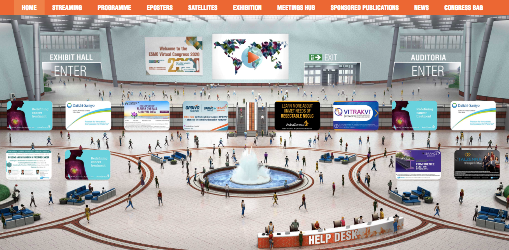ESMO 2020 was the next congress to go virtual, and it represented a fine achievement in virtual conferencing. The online environment simulated the physical visit, for example by showing the entrance hall with entrances to the exhibition hall, helpdesk, and auditoria (see image). Looking on the bright side of the Covid-19 crisis, the online content of medical conferences has received an enormous boost over the past months. Although physical meetings still have many advantages, we will benefit from the current experiences in the coming years, with hybrid forms of congresses.

ESMO Virtual Congress 2020 entrance hall
Please find below a short introduction to some of the most interesting content presented at ESMO 2020.
Prof. Margel (IL) presented the results of the imaging-based screening of 188 germline BRCA1/2 carriers (presentation ID LBA 22). An age-stratified PSA protocol was combined with mpMRI. A total of 8.5% had prostate cancer, with 44% intermediate to high risk. In patients >55, PSA was an acceptable way to triage before MRI.
Dr. Dai (CN) addressed local therapy for the prostate in patients with oligometastatic (=<5 bone or extrapelvic node lesions) disease (presentation ID 618 MO). In a prospective randomized controlled trial, ADT (N=100) only was compared to ADT + surgery (N=85) or radiation (N=15). The progression-free survival after radiation therapy favoured the ADT + local therapy group (33 vs 19%) after 28 months.
Dr. Tran (AU), who also gave a video interview to us, presented the results of a phase-1 study of a novel PSMA-targeted, bispecific T-cell engager immunotherapy (BiTE®) for metastatic CRPC (presentation ID 6090). In patients with different previous lines of therapy, PSA response was observed in 69% of the patients, with an acceptable safety profile.
Prof. James (GB) presented the long-term results of upfront abiraterone therapy in 1003 M+ patients during the Stampede trial (presentation ID 6110). Median overall survival was higher in the ADT + abiraterone group compared to ADT alone (6.6 versus 3.8 years), while the effects were independent from the risk group stratification according to the LATITUDE criteria.
The landscape of prostate cancer screening, diagnosis, and treatment is changing fast, with many exciting new developments expected in the next years.